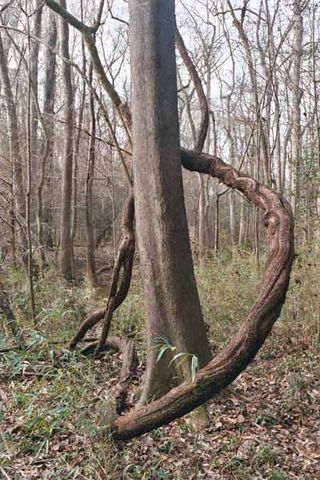Vines Take Over Southern U.S. Forests

Creeping vines are increasingly invading Southern forests, choking out trees and altering forest makeups.
Scientists say increased levels of carbon dioxide might be to blame.
The invasion involves more than kudzu, the woody vine of Japanese origin that can cost hundreds of millions of dollars in the southeastern United States annually in lost cropland and control measures.
A survey of two forests in South Carolina over the past two decades has revealed that vines such as grapevines, trumpet vine, poison ivy and Virginia creeper have been infiltrating the areas at increasingly higher rates, especially in newer woodlands.
Researchers evaluated the difference in vine density in an old-growth forest in South Carolina's Congaree National Park and a newer forest along the Savannah River and found that the number of vines in the older forest had doubled within 12 years, while there was a 10-fold increase in vines in the newer forest.
The patterns found in this study, detailed in an April issue of the journal Forest Ecology and Management, match those found by studies of other temperate and tropical forests, noted study leader Bruce Allen, of Ohio State University.
As the number of vines increases, the growth of trees may be jeopardized. The leaves of the vines fill the canopy and block sunlight that would otherwise reach the forest floor, so competing plants die because they can't get enough light.
Sign up for the Live Science daily newsletter now
Get the world’s most fascinating discoveries delivered straight to your inbox.
"There are so many vines that they're starting to change the makeup of the forest," Allen said. "It appears that as the number of vines increases, the density of small trees decreases at a fairly uniform rate."
Just why the vines are taking over is uncertain, but Allen and his colleagues speculate that increasing carbon dioxide concentrations that are fueling global warming could be benefiting vine growth more than tree growth.
"Many vines thrive on elevated levels of carbon dioxide," Allen said. "Several studies suggest that vines like poison ivy benefit more than other plants from higher CO2 levels."
- Top 10 Poisonous Plants
- Top 10 Surprising Results of Global Warming
- Images: Invasive Species

Andrea Thompson is an associate editor at Scientific American, where she covers sustainability, energy and the environment. Prior to that, she was a senior writer covering climate science at Climate Central and a reporter and editor at Live Science, where she primarily covered Earth science and the environment. She holds a graduate degree in science health and environmental reporting from New York University, as well as a bachelor of science and and masters of science in atmospheric chemistry from the Georgia Institute of Technology.
